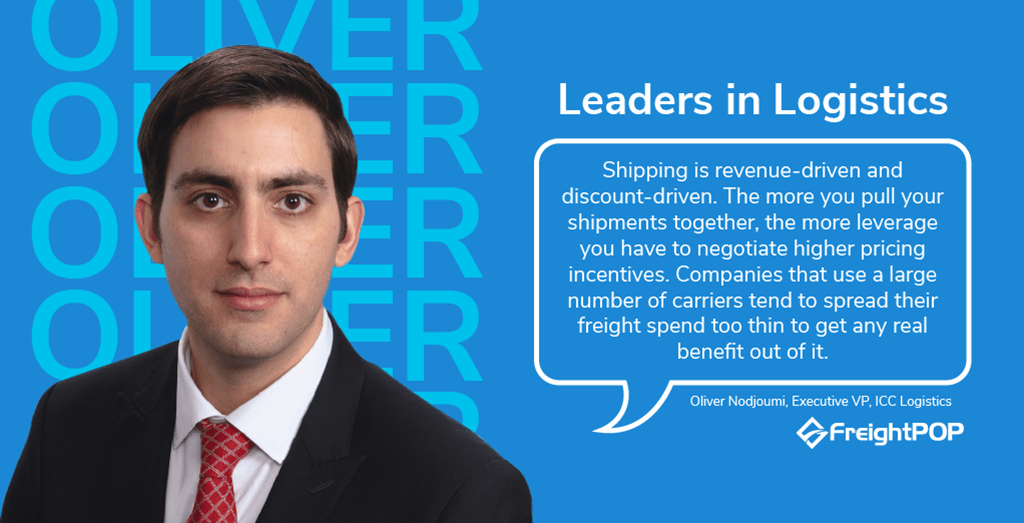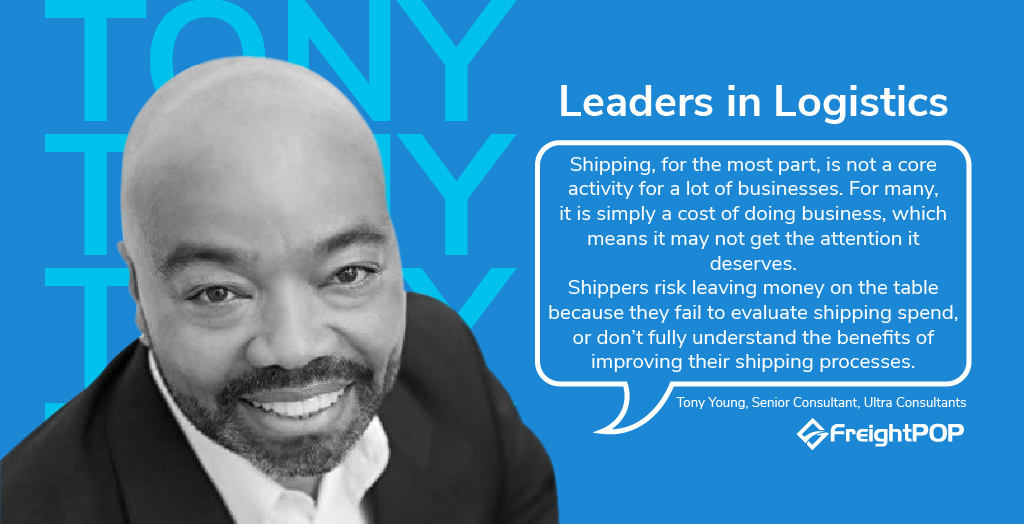Will Zone Skipping Help You Become More Competitive in 2026?
Could implementing a zone skipping tool give you a competitive advantage come 2026? We asked fulfillment, retail, and 3PL experts for their...
6 min read
FreightPOP : Apr 26, 2021

ICC Logistics' Oliver Nodjoumi talks about the importance of shipping data, how to revamp shipping service allocation to save money, and forecasts on COVID's ongoing impacts.
Want to be featured in our ongoing Leaders in Logistics feature? Reach out to our team!
Logistics consulting service ICC Logistics Services' Oliver Nodjoumi regularly assists shipping customers in reviewing and streamlining their processes and analyzing logistics contracts. He says data science is at the heart of what they do at ICC and that he enjoys his work due to how robust and dynamic the industry is.
Oliver: Poor technology.
The most important thing I've learned in my seven years in the industry is that shippers need to accurately understand risks, which they can only do by having clear data. To access clear data, you must have the right technology. With data, shippers can make actionable decisions.
The most significant indicator that someone's technology is not up to par is their data quality. Is their data providing all the shipping elements to give solid benchmarks? Or is it only giving four fields of information, and more than half the information is missing?
We often find many shipping departments making errors in how they benchmark one carrier's pricing proposal to another because they lack data insights.
Shippers need to understand it's 2021. It is entirely unacceptable not to have access to clear shipping information so you can make actionable decisions based on data.
CASE IN POINT: We had one experience where the shipper's head of accounting claimed they were spending around $1M a year on their domestic freight. After auditing their other divisions, whose invoicing was decentralized from the head company, we found they were actually spending $6M on their annual domestic freight. It was a huge discrepancy! And one easily resolved with technology.
Too many companies still rely on siloed systems and paper. And when you work with paper, it is easy to make mistakes and it takes enormous amounts of time to code. We have several customers using platforms like FreightPOP, which centralizes and integrates shipping data.
With such platforms, you can pull, say, all of a customer's small package shipping details and determine how much they are spending with UPS and FedEx from a top-level view. You can then use the data to compare similar companies to reveal where the customer is wasting money and identify opportunities.
Data is simply a massive piece of the logistics puzzle.
Oliver: One of the mistakes we see with freight and high volume shippers is how they allocate shipments on different service levels.
Every carrier has agreements designed to fit a particular type of shipment, such as ground shipping, express shipping, freight shipping, etc. The different tiers designate which type of service a shipment should go out on.
We commonly find that people are shipping things under more expensive levels than they need to and that they could save a lot of money by shipping at a lower level and still arrive at the destination at the same time.
Oliver: It comes down to management planning allocation better.
So let's say your company is using five carriers. How do you know which carrier should handle which lane and which type of freight for a particular customer shipment? Often it is whoever's the cheapest. Sometimes it is whoever's going to get it there the quickest.
But it should also depend on the benefits of the carrier contract. Why? Because shipping is revenue-driven and discount-driven. The more you pull your shipments together, the more leverage you have to negotiate higher pricing incentives. Companies that use a large number of carriers tend to spread their freight spend too thin to get any real benefit out of it.
By evaluating and making strategic decisions on how you are servicing shipments, companies can take advantage of discounts by giving higher volumes to certain carriers. And this does not mean using lesser quality carriers that are going to take longer to deliver.
Oliver: It's about pulling the revenue together to say to carriers, okay, I'll give you this committed volume, but I want to pay X, and these are the level of service tiers expected—such as, if you give me a 50% discount, I'll commit to X volume, and the discount automatically goes up to 60% if Y volume, and so on.
Committed volumes give the carrier and the shipper an incentive to have a much more structured relationship vs. one-off quotes for shipments. This also saves a shipper time in quoting shipments and frees up processing man-hours. Instead of getting individual quotes from 10 carriers on a shipment, now the shipper selects from, say, two or three carrier contracts.
Besides saving money, this strategy also benefits other departments. For example, maybe a shipper had a hundred shipments last month, with 36 different carrier invoice styles to contend with. Dwindling the number of carriers down means that they now have perhaps 2-3 carrier invoice types and companies to directly deal with.
Another example is on the operational side. When the warehouse and operations are dealing with fewer carriers, those relationships are stronger, cutting down on issue resolution.
Lastly, customers also benefit from the discounted shipping costs.
Oliver: This year has been insanely upside down with what's happened from COVID. The industry is in a stage where prices, reliability, and available services are in high demand. There simply isn't enough equipment out there in the world to facilitate what everyone needs to move when they need to move—and certainly not for the price they'd like to pay.
All of the chaos has led to the international freight market maintaining some of the highest prices in shipping history. For us as logistics consultants, right now we are involved in a lot of RFP proposals customers are asking us to administer.
For example, a company will indicate they spend $60M a year on ocean shipping and ask us to find them the best rates in the current market. We are finding that where they used to pay $2,400 on a container shipment last year, that same shipment is now $7,000. And that's the best in class rate!
We have customers that need to move around 30,000 ocean containers in a year, which, in previous years, carriers would be fighting for that business. But now, carriers are offering $10,000—a 300% markup from last year!
Even companies as large as Walmart, which is the largest importer in the world, are getting hit with these increases and are finding that their traditional carriers cannot handle all their volume.
CASE IN POINT: We had a customer who could not get their freight on the water to meet all their volume and get it to the U.S. in time. So they opted to ship it via air on several hollowed out 747s, of which there only a finite number of them in the world, and go for a costly premium.
The cost was roughly a million dollars per flight. And, of course, the customer was mortified and opted to wait things out a month, hoping the market would do something. A month later, they still could not get on the water, and that same flight was now $1.4M.
Oliver: It's important to move what you need to move and understand the price you need to move it at. This is going to be a critical issue for 2021.
The steamship lines have all this demand, and the capacity available for that demand is fixed. When this occurs, the price is the first thing to be affected. So, if you want the space, understand you will be paying a premium for it.
We see prices as high as $15,000 to move a container from China to LA, with a local delivery inside LA that should typically cost $4-5K.
Shippers see the costs going up, but they don't understand fully why. The reality is, there's so much demand. And the market only has so much equipment. This was an issue before COVID, but COVID really fanned the flames.
Oliver: Once containers get to port, they are taking much longer to make their roundtrip back to Asia than they typically did. Containers are being staggered across the globe. You have steamship lines begging for containers they sent out three months ago, and because of COVID impacts and other issues, there is severe congestion at the ports. The big ship that blocked the Suez Canal itself created a 90-day ripple effect. An entire lane is severely impacted for three months because of that ship.
And all that freight that finally comes into port needs to go on a truck and head to a warehouse or distribution center. These costs are all much higher now—and that is without any natural disaster impacts, which unfortunately can still happen this year as well.
So the rest of 2021 will continue to see high demands, a lack of equipment globally, and freight rates that will remain at historically high levels.
CASE IN POINT: Disruptions in international freight ripples into domestic trucking. But there are also issues in the country that create significant disruptions as well. The energy grid disaster in Texas, for example, greatly impacted a number of our customers.
We had customers who had contracts for freight to be moved, and then truckers were flat out refusing to pick up their freight during the disaster because businesses were offering double the amount to move generators down to Houston.
Everyone is at the mercy of the limited number of trucks out there. The limited number of drivers. The limited number of containers. The limited number of steamships.
The best advice for shippers right now is to forecast and allocate what absolutely has to be moved. And then give longer lead times, like six weeks advance notice vs. one week. Shippers must be flexible. And they require redundancies to prepare for primary shippers not moving their goods.
![]()
It is time to give you more control over your supply chain. Use our new guide to see how!

Could implementing a zone skipping tool give you a competitive advantage come 2026? We asked fulfillment, retail, and 3PL experts for their...

In this week's Leaders in Logistics feature, we talk to a NetSuite expert who shares insights on cloud ERP integrations and the different needs and...

LEADERS IN LOGISTICS: Tony Young, a senior ERP consultant from Ultra Consultants shares his insight on digitizing logistics, where many shippers...